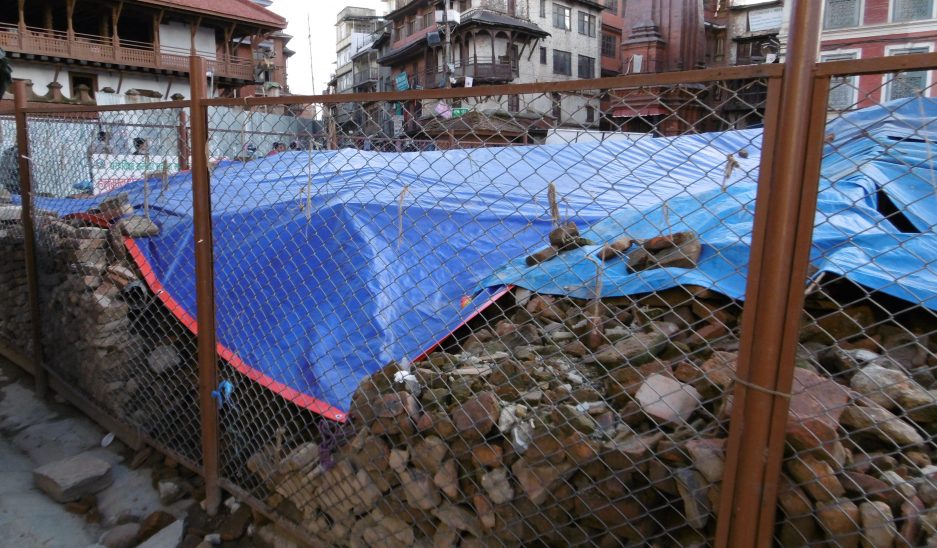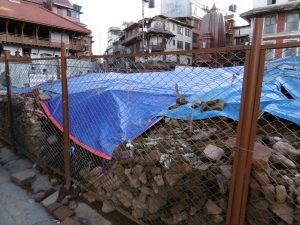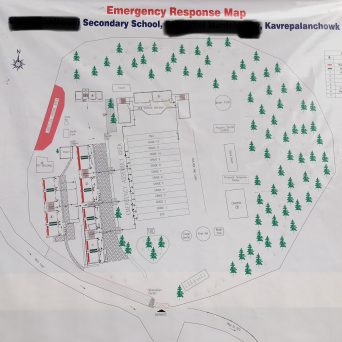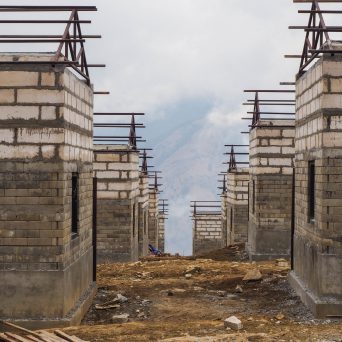
Rebuilding Cultural Memories And Kasthamandap, by Stefanie Lotter
With a sturdy blue zinc roof protecting its foundations, the site of Kasthamandap, the oldest and largest communal building in Kathmandu, now looks ready for all weathers. The transition from ruin to restoration lengthened visibly as the corrugated roof replaced the red and blue tarpaulin which previously lay over the site. Waterproof cloth covers of various sizes had marked the previous attempt by the community group ‘Rebuild Kasthamandap’ (http://www.rebuildkasthamandap.com) to protect the site from the second post-earthquake monsoon.
To me the crumbled tarpaulin, sunken in places and filled with water puddles, together with a pile of irregular bamboo poles, had conveyed a reassuring impermanence. The impression that something was moving had been comforting. Each time I passed during summer 2017, the site looked slightly different, as if rebuilding had already begun. But now, ironically, the much better roof marks a standstill, a more permanent settling into the transitional period of not-quite-yet rebuilding.
The protection of the site became a political issue last summer, when the city felt that it had to be seen to be saving the bare foundations from the penetrating rain with a well-constructed roof, rather than simply leaving this to a community group. In the first monsoon after the earthquake, a layer of ‘rubble’ covered the foundations, hiding their treasure beneath. It was clear that Kasthamandap had foundations, but their value had not been acknowledged. The first plan to rebuild Kasthamandap, put forward by Manohar Rajbhandari, included a concrete and pile foundation:this would have removed at least part of the old foundations to make way for a sturdy new construction. This suggests that the importance of the ancient foundations had not been considered at this early stage.
What had been invisible before, and not referred to either in documents or in rituals, was temporarily forgotten.
Halbwachs[1] reminds us that ‘history begins only at the point where tradition ends, at a moment when social memory is extinguished or decomposes.’
The portion of the monument that stood above ground, and the monument’s social life, had captured the attention so far, because the laying of such complex foundations under ground is a forgotten technique – though it is one now likely to be revived. When we discuss cyclical renewals in crafts, nobody anticipates that traditions such as laying foundations would have to be remembered for a millennium. Newly documented and dated by a team of archaeologists, including Robin Coningham from the University of Durham, Kasthamandap’s foundations are now thought to extend even further back than previously supposed, to around 700AD. The extent of the foundation is enormous, its shape, a mandala, significant. Science had to step in to prove the past when neither historical documents nor traditions had retained this knowledge.

How the past is put to use in the future, when Kasthamandap is rebuilt and brought into use once again, will be an interesting process. Authenticity, as Gutschow and Weiler (2016) remind us, can be based on so many different aspects of the past. Aside from questions of material originality, place value, a living tradition of craftspeople, and the continuity of community can also be identified as sources of authenticity. Kasthamandap has been used by a variety of people as a restplace and shelter over the centuries. The community group ‘Rebuild Kasthamandap’ has begun to collect all forms of cultural and communicative memory associated with the monument. Let us hope that community participation in rebuilding Kasthamandap will be as inclusive as its former use had been.
After all, it is the intangible heritage that can bring life back to the place, and ensure that the new Kasthamandap will strike us not just as a true copy, but as the authentic monument recreated.
[1] Halbwachs (1992) as translated in Hartman (1995).
Bibliography
Assman, Jan 2011. Cultural Memory and Early Civilization: Writing, Remembrance, and Political Imagination. Cambridge University Press.
Coningham, R.A.E., Acharya, K.P., Davis, C.E., Kunwar, R.B., Simpson, I.A., Schmidt, A. & Tremblay, J.C. (2016). ‘Preliminary Results of Post-Disaster Archaeological Investigations at the Kasthamandap and within Hanuman Dhoka, Kathmandu Valley UNESCO World Heritage Property (Nepal).’ Ancient Nepal 191-192: 28-51
Halbwachs, Maurice 1992. On Collective Memory. University of Chicago Press.
Weiler, Katharina and Niels Gutschow (ed.) 2016. Authenticity in Architectural Heritage Conservation: Discourses, Opinions, Experiences in Europe, South and East Asia. Heidelberg: Springer.



